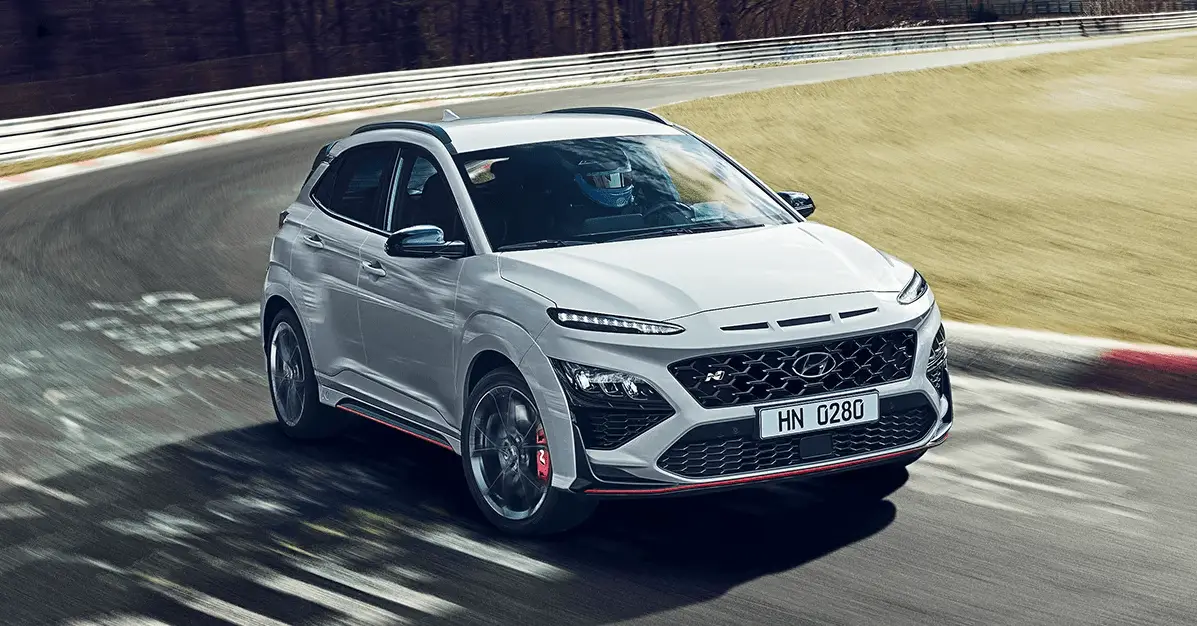Hyundai Kona-N 2023 Dual Clutch Transmission
The innovative Dual Clutch Transmission (DCT) of the 2023 Hyundai Kona-N redefines driving dynamics in this high-performance small SUV. With the speed and agility of a manual gearbox combined with the efficiency of an automatic transmission, this cutting-edge gearbox delivers lightning-fast gear shifts for thrilling acceleration and agile handling. The 2023 Kona-N’s DCT is a notable feature that enhances the vehicle’s performance-oriented nature, offering a thrilling and dynamic driving experience whether negotiating metropolitan streets or twisting mountain roads.
2023 Hyundai KONA Specs, Price, Features, Milage (Brochure)
Dual Clutch Transmission

- Depress the brake pedal and press the shift button ahead of the shift lever while moving the shift lever.
- Press the shift button while moving the shift lever.
- The shift lever can freely operate.
Dual Clutch Transmission Operation
The dual-clutch transmission has eight forward speeds and one reverse speed. The individual speeds are selected automatically when the shift lever is in the D (Drive) position.
- The dual-clutch transmission can be thought of as an automatically shifting manual transmission. It gives the driving feel of a manual transmission, yet provides the ease of a fully automatic transmission.
- When D (Drive) is selected, the transmission will automatically shift through the gears similar to a conventional automatic transmission. Unlike a traditional automatic transmission, the gear shifting can sometimes be felt and heard as the actuators engage the clutches and the gears are selected.
- transmission will automatically shift through the gears similar to a conventional automatic transmission. Unlike a traditional automatic transmission, the gear shifting can sometimes be felt and heard as the actuators engage the clutches and the gears are selected. incorporates a wet-type dual-clutch mechanism, which allows for better acceleration performance and increased fuel efficiency while driving. However, it differs from a conventional automatic transmission because it does not incorporate a torque converter. Instead, the transition from one gear to the next is managed by clutch slip, especially at lower speeds.
As a result, shifts are sometimes more noticeable, and a light vibration can be felt as the transmission shaft speed is matched with the engine shaft speed. This is a normal condition of the dual-clutch transmission. - The wet-type clutch transfers torque more directly and provides a direct-drive feeling which may feel different from a conventional automatic transmission. This may be more noticeable when launching the vehicle from a stop or when traveling at low, stop-and-go vehicle speeds.
- When rapidly accelerating from a lower vehicle speed, the engine RPM may increase dramatically as a result of clutch slip as the dual-clutch transmission selects the correct gear. This is a normal condition.
- When accelerating from a stop on an incline, press the accelerator smoothly and gradually to avoid any shuddering or jerkiness.
- When traveling at a lower vehicle speed, if you release the accelerator pedal quickly, you may feel engine braking before the transmission changes gears. This engine braking feeling is similar to operating a manual transmission at low speed.
- When driving downhill, you may wish to move the gear shift lever to Manual Shift mode and downshift to a lower gear in order to control your speed without using the brake pedal excessively.
- When you turn the engine on and off, you may hear clicking sounds as the system goes through a self-test. This is a normal sound for the dual-clutch transmission.
- During the first 1000 miles (1,500km), you may feel that the vehicle may not be smooth when accelerating at low speed. During this break-in period, the shift quality and performance of your new vehicle is continuously optimized.
WARNING
To reduce the risk of serious injury or death:
ALWAYS check the surrounding areas near your vehicle for people, especially children, before shifting a vehicle into D (Drive) or R (Reverse). Before leaving the driver’s seat, always make sure the shift lever is in the P (Park) position, then set the parking brake, and place the Engine Start/Stop button to the OFF position. Unexpected and sudden vehicle movement can occur if these precautions are not followed. Do not use aggressive engine braking (shifting from a higher gear to a lower gear) on slippery roads. This could cause the tires to slip and may result in an accident.
NOTICE
Always come to a complete stop before shifting into D (Drive) or R (Reverse). Do not put the shift lever in N (Neutral) while driving.
WARNING
Due to transmission failure, you may not continue to drive and the position indicator and the position indicator (D, P) on the instrument cluster will blink. Contact the authorized HYUNDAI dealer and have the system checked.
DCT warning messages
This warning message is displayed when the vehicle is driven slowly on a grade and the vehicle detects that the brake pedal is not applied.
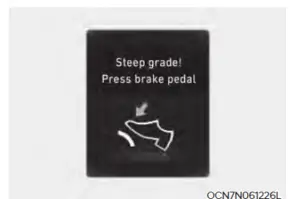
Steep grade! Press brake pedal
Driving up hills or on steep grades:
- To hold the vehicle on an incline use the foot brake or the parking brake.
- When in stop-and-go traffic on an incline, allow a gap to form ahead of you before moving the vehicle forward. Then hold the vehicle on the incline with the foot brake.
- If the vehicle is held or creeping forward on an incline by applying the accelerator pedal, the clutch and transmission may overheat which can result in damage. At this time, a warning message will appear on the LCD display.
- If the LCD warning is active, the foot brake must be applied.
- Ignoring the warnings can lead to damage to the transmission.
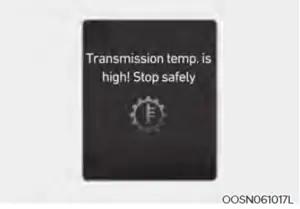
Transmission high temperature
Under certain conditions, such as repeated stop-and-go launches on steep grades, sudden take-off or acceleration, or other harsh driving conditions, the transmission clutch temperatures will increase excessively. Finally, the clutch in the transmission could be overheated. When the clutch is overheated, the safe protection mode engages and the gear position indicator on the cluster blinks with a chime. At this time, the “Transmission temp. is high! Stop safely” warning message will appear on the LCD display and driving may not be smooth. If this occurs, pull over to a safe location, stop the vehicle with the engine running, apply the brakes shift the vehicle to P (Park), and allow the transmission to cool. If you ignore this warning, the driving condition may become worse. You may experience abrupt shifts or Jerkiness. To return to normal driving conditions, stop the vehicle and apply the foot brake or shift into P (Park). Then allow the transmission to cool for a few minutes with the engine on, before driving off. When possible, drive the vehicle smoothly.
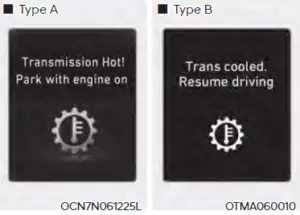
Transmission overheated
If the vehicle continues to be driven and the clutch temperatures reach the maximum temperature limit, the “Transmission Hot! Park with engine on” warning will be displayed. When this occurs the clutch is disabled until the clutch cools to normal temperatures. The warning will display a time to wait for the transmission to cool.If this occurs, pull over to a safe location, stop the vehicle with the engine running, apply the brakes shift the vehicle to P (Park), and allow the transmission to cool. When the message “Trans cooled. Resume driving” appears you can continue to drive your vehicle. When possible, drive the vehicle smoothly. If any of the warning messages in the LCD display continue to blink, for your safety, contact an authorized HYUNDAI dealer and have the system checked
Transmission ranges
The indicator in the instrument cluster displays the shift lever position when the Engine Start/Stop button is in the ON position.
P (Park)
Always come to a complete stop before shifting into P (Park). To shift from P (Park), you must depress firmly on the brake pedal and make sure your foot is off the accelerator pedal. If you have done all of the above and still cannot shift the lever out of P (Park), see “Shift-Lock Release” in this chapter. The shift lever must be in P (Park) before turning the engine off
WARNING
Shifting into P (Park) while the vehicle is in motion may cause you to lose control of the vehicle. After the vehicle has stopped, always make sure the shift lever is in P (Park), apply the parking brake, and turn the engine off. When parking on an incline, place the shift lever in P (Park) and apply the parking brake to prevent the vehicle from rolling downhill. For safety, always engage the parking brake with the shift lever in the P (Park) position except for the case of emergency parking.
R (Reverse)
Use this position to drive the vehicle backward.
NOTICE
Always come to a complete stop before shifting into or out of R (Reverse); you may damage the transmission if you shift into R (Reverse) while the vehicle is in motion.
N (Neutral)
The wheels and transmission are not engaged. Use N (Neutral) if you need to restart a stalled engine, or if it is necessary to stop with the engine ON. Shift into P (Park) if you need to leave your vehicle for any reason. Always depress the brake pedal when you are shifting from N (Neutral) to another gear.
WARNING
Do not shift into gear unless your foot is firmly on the brake pedal. Shifting into gear when the engine is running at high speed can cause the vehicle to move very rapidly. You could lose control of the vehicle and hit people or objects.
D (Drive)
This is the normal driving position. The transmission will automatically shift through an 8-gear sequence, providing the best fuel economy and power. For extra power when passing another vehicle or driving uphill, depress the accelerator fully. The transmission will automatically downshift to the next lower gear (or gears, as appropriate).
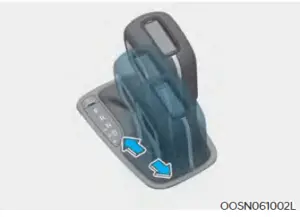
Manual shift mode
Whether the vehicle is stationary or in motion, manual shift mode is selected by pushing the shift lever from the D (Drive) position into the manual gate. To return to D (Drive) range operation, push the shift lever back into the main gate. In Manual Shift mode, moving the shift lever backward (B) and forwards (A) will allow you to select the desired range of gears for the current driving conditions.
+ (Up) : Pull the lever backwards(B) once to shift up one gear.
– (Down) : Push the lever forward(A) once to shift down one gear.
Information
- Only the eight forward gears can be selected in Manual Shift Mode. To reverse or park the vehicle, move the shift lever to the R (Reverse) or P (Park) position as required.
- Downshifts are made automatically when the vehicle slows down. When the vehicle stops, 1st gear is automatically selected.
- When the engine RPM approaches the red zone the transmission will upshift automatically.
- If the driver presses the lever to the + (Up) or – (Down) position, the transmission may not make the requested gear change if the next gear is outside of the allowable engine RPM range. The driver must execute upshifts in accordance with road conditions, taking care to keep the engine RPMs below the red zone.
Paddle shifter
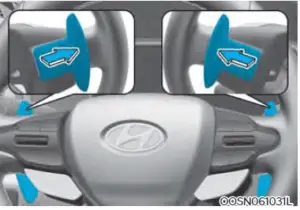
The paddle shifter is functional when the shift lever is in the D (Drive) position or the manual shift mode.
With the shift lever in the D position
The paddle shifter will operate when the vehicle speed is more than 3km/h. Pull the [+] or [-] paddle shifter once to shift up or down one gear and the system changes from automatic mode to manual mode. When the vehicle speed is lower than 2 km/h, if you depress the accelerator pedal for more than 6 seconds (in the Normal mode) or if you move the shift lever from D (Drive) to manual shift mode and move it from manual shift mode to D (Drive) again, the system changes from manual mode to automatic mode. When releasing the paddle shifter, pull it for more than 1 second.
With the shift lever in the manual shift mode
Pull the [+] or [-] paddle shifter once to shift up or down one gear.
Information
If the [+] and [-] paddle shifters are pulled at the same time, gear shift may not occur.
Shift-lock system
For your safety, the dual-clutch transmission has a shift-lock system that prevents shifting the transmission from P (Park) to R (Reverse) unless the brake pedal is depressed.
To shift the transmission from P (Park) into R (Reverse):
- Depress and hold the brake pedal.
- Start the engine.
- Move the shift lever to R (Reverse).
Shift-lock release
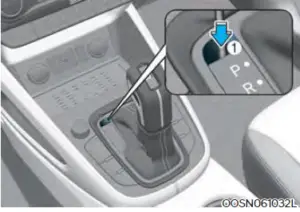
If the shift lever cannot be moved from the P (Park) position into the R (Reverse) position with the brake pedal depressed, continue depressing the brake, and then do the following:
- Set the Engine Start/Stop button in the OFF position.
- Apply the parking brake.
- Carefully remove the cap (1) covering the shift-lock release access hole.
- Insert a tool (for example, a flathead screwdriver) into the access hole and press down on the tool.
- Move the shift lever while holding down the screwdriver.
- Remove the tool from the shift-lock release access hole then install the cap.
- Depress the brake pedal, and then restart the engine.
If you need to use the shift-lock release, have your vehicle inspected by an authorized HYUNDAI dealer immediately.
Parking
Always come to a complete stop and continue to depress the brake pedal. Move the shift lever into the P (Park) position, and apply the Set the Engine Start/Stop button in the OFF position. Take the key with you when exiting the vehicle.
WARNING
When you stay in the vehicle with the engine running, be careful not to depress the accelerator pedal for a long period of time. The engine or exhaust system may overheat and start a fire. The exhaust gas and the exhaust system are very hot. Keep away from the exhaust system components. Do not stop or park over flammable materials, such as dry grass, paper, or leaves. They may ignite and cause a fire.
Good Driving Practices
- Never move the shift lever from P (Park) or N (Neutral) to any other position with the accelerator pedal depressed.
- Never move the shift lever into P (Park) when the vehicle is in motion.
Be sure the vehicle is completely stopped before you attempt to shift into R (Reverse) or D (Drive). - Do not move the shift lever to N (Neutral) when driving. Doing so may result in an accident because of a loss of engine braking and the transmission could be damaged.
- When driving uphill or downhill, always shift to D (Drive) for driving forward or shift to R (Reverse) for driving rearwards. After selecting
D (Drive) or R (Reverse), check the gear position indicated on the cluster before driving. If the vehicle moves in the opposite direction of the selected gear, the engine may turn off and a serious accident might occur due to degraded brake performance. - Do not drive with your foot resting on the brake pedal. Even light, but consistent pedal pressure can result in the brakes overheating, brake wear and possibly even brake failure.
- Depressing both accelerator and brake pedals at the same time can trigger logic for engine power reduction to assure vehicle deceleration. Vehicle acceleration will resume after the brake pedal is released.
- When driving in Manual Shift mode, slow down before shifting to a lower gear. Otherwise, the lower gear may not be engaged if the engine RPMs are outside of the allowable range.
- When driving with shifter paddles, slow down before shifting to a lower gear. Otherwise, the lower gear may not be engaged if the engine RPMs are outside of the allowable range.
- Always apply the parking brake when leaving the vehicle. Do not depend on placing the transmission in P (Park) to keep the vehicle from moving.
- Exercise extreme caution when driving on a slippery surface. Be especially careful when braking, accelerating or shifting gears. On a slippery surface, an abrupt change in vehicle speed can cause the drive wheels to lose traction and may cause loss of vehicle control resulting in an accident.
- Optimum vehicle performance and economy is obtained by smoothly depressing and releasing the accelerator.
WARNING
To reduce the risk of SERIOUS INJURY or DEATH:
- ALWAYS wear your seatbelt. In a collision, an unbelted occupant is significantly more likely to be seriously injured or killed than a properly belted occupant.
- Avoid high speeds when cornering or turning.
- Do not make quick steering wheel movements, such as sharp lane changes or fast, sharp turns.
- The risk of rollover is greatly increased if you lose control of your vehicle at highway speeds.
- Loss of control often occurs if two or more wheels drop off the roadway and the driver oversteers to reenter the roadway.
- In the event your vehicle leaves the roadway, do not steer sharply. Instead, slow down before pulling back into the travel lanes.
- HYUNDAI recommends you follow all posted speed limits.
FAQ
The DCT in the 2023 Hyundai Kona-N is an advanced transmission system that combines the efficiency of an automatic transmission with the precision of a manual gearbox.
The DCT in the 2023 Kona-N is likely to have 8 gears, providing a wide range of options for different driving scenarios.
DCTs offer faster and smoother gear shifts, enhancing both performance and fuel efficiency.
Yes, the DCT allows for manual gear selection using paddle shifters, giving you more control over your driving experience.
The DCT provides lightning-fast gear changes, resulting in quick acceleration and improved handling, making the driving experience more engaging and dynamic.
Yes, DCTs are known for their ability to improve fuel efficiency compared to traditional automatic transmissions.
It’s likely that the 2023 Kona-N will have different driving modes that can adjust the DCT’s behavior to suit various driving conditions.
Yes, some DCT systems offer customization options, allowing you to tailor the transmission’s behavior to your liking.
Absolutely, the DCT is a crucial component for delivering the sporty and dynamic driving experience expected from a high-performance vehicle like the Kona-N.
While DCTs are generally reliable, regular transmission maintenance, such as fluid changes, is recommended to ensure longevity and optimal performance.
DCTs are well-suited for stop-and-go traffic due to their quick and smooth gear changes, providing a comfortable driving experience.
While DCTs excel in sporty and on-road driving, they may not be the ideal choice for extreme off-road conditions that require low-speed crawling.
Launch control is a possibility, as many high-performance vehicles equipped with DCTs offer this feature to optimize acceleration from a standstill.
Yes, modern DCTs are equipped with sensors and software that can adapt to various driving conditions, optimizing gear changes accordingly.
DCTs are generally known for their durability, but regular maintenance is essential to ensure long-term reliability.
Useful Link
View Full User Guide: Hyundai Kona-N 2023 User Guide
Download Manuals: https://owners.hyundaiusa.com/us/en/resources/manuals-warranties.html
2023 Hyundai KONA Specs, Price, Features, Milage (Brochure)

